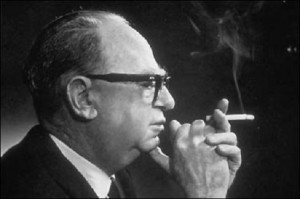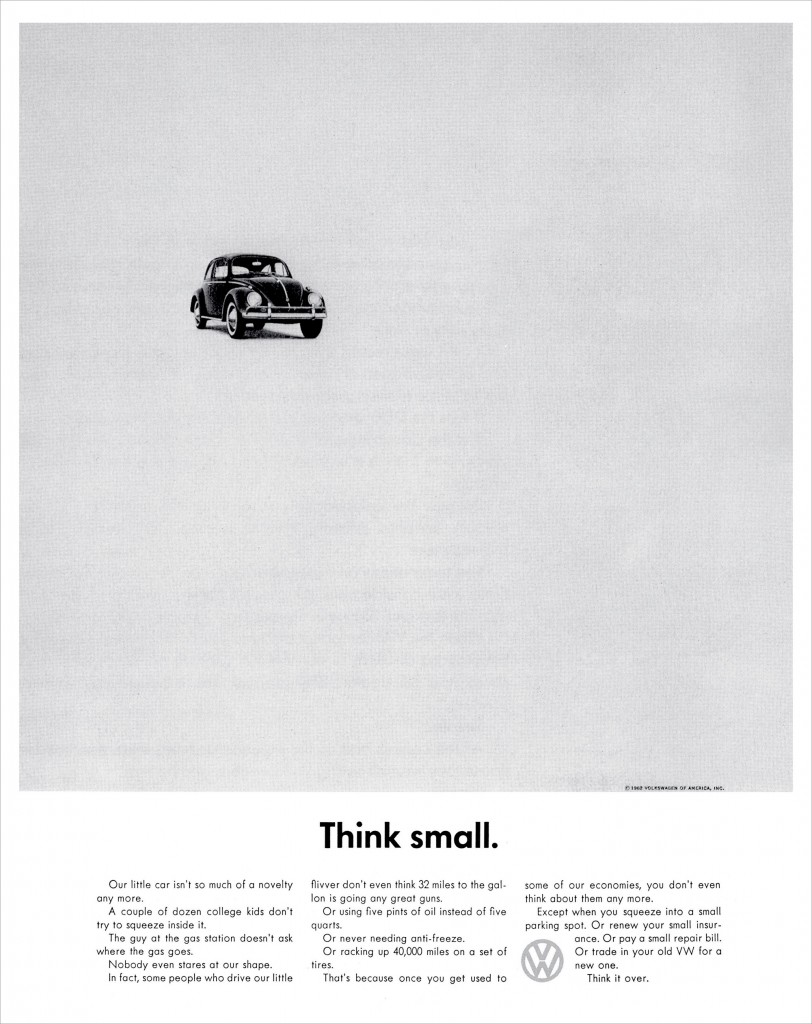
The common thread these icons all share is Leo Burnett, quite possibly the greatest “ad man” of the 20th century. Burnett isn’t just responsible for the Jolly Green Giant, Tony the Tiger, and the Marlboro Man. What Leo Burnett did was bigger… much bigger…
Synthesizing Art & Copy
Prior to the 1950s, advertising was heavily influenced by text. Typically, the text appeared below a single image and was written to persuade the consumer to buy the product. Truthfulness came second (or third or fourth). (Leo Burnett, in contrast, knew that, “Regardless of the moral issue, dishonesty in advertising has proved very unprofitable.”)
During the 1950s and 1960s, this “image + long form text” strategy began to change. The growth of advertising agencies brought about a “Creative Revolution,” a period during which art and copywriting came together to produce symbolic advertising. Take the iconic 1960s “VW: Think Small,” advertisement as an example:
While we’re used to this kind of advertising in 2013, it was a completely revolutionary way of promoting a product and building a brand. But “revolutionary” was exactly what Burnett was. Check out eleven of his tips, applicable to any business owner looking to build a brand with good ad copy.
Leo Burnett on What Makes a Good Ad
“Advertising says to people, ‘Here’s what we’ve got. Here’s what it will do for you. Here’s how to get it.’”
“Good advertising does not just circulate information. It penetrates the public mind with desires and belief.”
“We want consumers to say, ‘That’s a hell of a product’ instead of, ‘That’s a hell of an ad.’”
“Make it simple. Make it memorable. Make it inviting to look at. Make it fun to read.”
Leo Burnett on Authenticity
“The greatest thing to be achieved in advertising, in my opinion, is believability, and nothing is more believable than the product itself.”
“If you can’t turn yourself into your customer, you probably shouldn’t be in the ad writing business at all.”
“If you are writing about baloney, don’t try to make it Cornish hen, because that is the worst kind of baloney there is. Just make it darned good baloney.”
Leo Burnett on Creativity in Business
“The sole purpose of business is service. The sole purpose of advertising is explaining the service which business renders.”
“I have learned that you can’t have good advertising without a good client, that you can’t keep a good client without good advertising, and no client will ever buy better advertising than he understands or has an appetite for.”
“There’s no such thing as ‘hard sell’ and ‘soft sell.’ There’s only ‘smart sell’ and ‘stupid sell.’”
“Curiosity about life in all of its aspects, I think, is still the secret of great creative people.”
What’s your favorite Leo Burnett quote? (All quotes from ThinkExst.com.)
